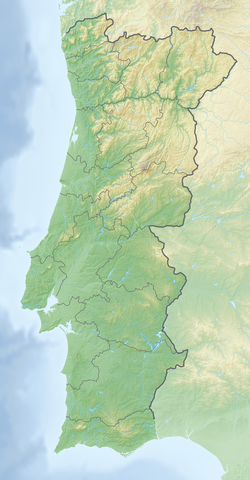Papo Seco Formation
| Papo Seco Formation | |
|---|---|
| Stratigraphic range: Early Barremian ~ | |
| Type | Geological formation |
| Underlies | Assises à Orbitolines Formation |
| Overlies | Porto da Calada Formation |
| Lithology | |
| Primary | Mudstone, siltstone |
| Other | Sandstone |
| Location | |
| Coordinates | 38°24′N 9°12′W / 38.4°N 9.2°W |
| Approximate paleocoordinates | 31°48′N 1°18′E / 31.8°N 1.3°E |
| Region | Setubal |
| Country | |
| Extent | Lusitanian Basin |
The Papo Seco Formation is a geological formation in Portugal, whose strata date back to the Early Cretaceous. Dinosaur fossils are among the fossils that have been recovered from the formation.[1][2]
Name
The unit was previously referred to as the "Gres a Dinosauriens", due to the abundant dinosaur remains found in the past.[3]
Description
The Papo Seco Formation (Rey, 1992) marks the return to clastic-dominated sedimentation. Exposure of the formation is found above the low cliff between Rochadouro and Areia do Mastro, and on the foreshore and beach at Boca do Chapim. The Papo Seco Formation is dominated by silty mud-mud deposition. This is interbedded with medium to coarse, commonly ribbon shaped, clastic sandstones. Along the exposure, between Rochadouro and Boca do Chapim, the clastic sands are not laterally continuous. The exposure clearly shows that the ribbon sands are isolated and change laterally into muds. Three distinct sand facies have been identified within the Papo Seco Formation.[3]
Vertebrate paleofauna
| Ornithischians of the Papo Seco Formation | ||||
|---|---|---|---|---|
| Taxa | Presence | Notes | Images | |
|
Genus:
|
|
|
||
|
Genus:
|
|
|||
|
Suborder:
|
|
| ||
Correlation
See also
References
Bibliography
- Weishampel, David B.; Peter Dodson, and Halszka Osmólska (eds.). 2004. The Dinosauria, 2nd edition, 1–880. Berkeley: University of California Press. Accessed 2019-02-21.ISBN 0-520-24209-2
- Aillud, Gary Stefan. 2001. Palaeoecology, palaeoenvironmental analysis and their application to Sequence Stratigraphy: Lower Cretaceous, Lusitanian Basin, Portugal, 1–360. University of Plymouth. Accessed 2017-10-02.
Further reading
- S. Figueiredo, I. Bachtsevanidou Strantzali, M. Gomes, R. Pimenta, and M. Santos. 2017. Preliminary Data of New Dinosaurs and Turtles Remains from the basal Deposits of the Papo-Seco Formation in Areias do Mastro's Quarry (Cabo Espichel - Portugal). Arnava 6(1):117-130




